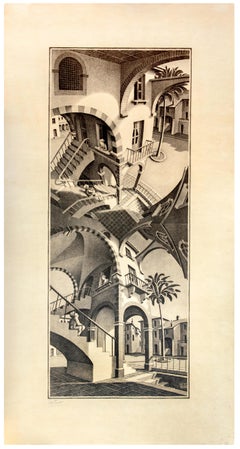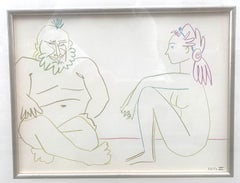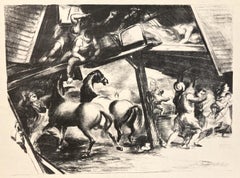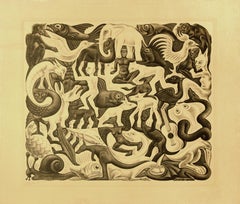M.C. (Maurits Cornelius) Escher Figurative Prints
Nothing is quite what it seems in the universe of Maurits Cornelis Escher (widely known as M.C. Escher). The Dutch artist, famed for his graphic prints featuring infinite staircases, twisted perspectives and self-replicating animals, was a master of illusion in more ways than one.
Escher's pictures aren’t simply puzzles designed to play tricks on the brain; they were born of a desire to stretch our powers of perception, to encourage us to cultivate a natural curiosity and playfulness about the world around us. According to New York gallerist Skot Foreman, the artist had a rare gift. “He combined the structure and analytics of the left brain with the artistic creativity of the right brain,” Foreman explains. “Somehow, he turned images into mind-bending universes that were able to stretch the boundaries of our imagination, urging us to rethink the realms of possibility within nature’s laws of order.”
But creating illusionistic illustrations was not Escher’s only talent. He was also a passionate diarist, recording his thoughts and frustrations in written form throughout his life. He often lamented that his pictures could never fully convey his cerebral imaginings. At the same time, he expressed impatience with those who couldn’t see beyond the surface appeal of his shape-shifting patterns. Escher was an artist who sought perfection and felt misunderstood by the mainstream art world.
“The most important thing about Escher is that he was always curious, always researching and exploring. Most people lose this quality as they get older, but Escher maintained a childlike enthusiasm for the world,” says Dutch filmmaker Robin Lutz, whose thoughtful feature-length film, M.C. Escher: Journey to Infinity, marries documentary footage with animation and unfolds at an unhurried pace, allowing Escher’s witty and intelligent prose to gently guide us through his creative evolution.
Escher always carried a magnifying glass in his pocket to “enjoy the tiniest details” at his feet, be it a plant climbing a rock, a butterfly or a grasshopper. He had a real passion for travel and spent more than a decade in Rome with his wife, Jetta, and young family. It was there that he first played with multiple perspectives, sketching the city’s architecture at night to avoid the “excessive baroque frills” he deemed too distracting in the daylight. Another big development was sparked by a 1936 visit to the Alhambra palace in Granada, Spain. Inspired by the Moorish tiles of the 14th-century landmark, Escher started to experiment with repeating patterns, or tessellations, creating his first woodcuts and lithographs of metamorphosing birds, lizards and fish interlocking and filling the entire surface of the paper in jigsaw fashion.
During and directly after World War II, Escher produced many of his most famous works, emotional reactions to a world plunged into chaos. This period marked the start of his fascination with impossible staircases, never-ending waterfalls and cyclical still lifes featuring figures and creatures seemingly caught in a loop, a paradox of entrapment and renewal.
Indeed, the concept of infinity was a major inspiration for him. It informs his fish-eye studies and curvilinear perspectives, which cram in so much dizzying detail it’s impossible to know where one thing ends and another begins. It’s no wonder, then, that Escher’s probing, mind-expanding prints have such enduring appeal.
Find original M.C. Escher art on 1stDibs.
1940s Modern M.C. (Maurits Cornelius) Escher Figurative Prints
Lithograph
1950s Modern M.C. (Maurits Cornelius) Escher Figurative Prints
Lithograph
1930s American Modern M.C. (Maurits Cornelius) Escher Figurative Prints
Lithograph
1940s American Modern M.C. (Maurits Cornelius) Escher Figurative Prints
Lithograph
1970s Modern M.C. (Maurits Cornelius) Escher Figurative Prints
Lithograph
1980s Modern M.C. (Maurits Cornelius) Escher Figurative Prints
Lithograph, Offset
Mid-20th Century Modern M.C. (Maurits Cornelius) Escher Figurative Prints
Lithograph
1930s American Modern M.C. (Maurits Cornelius) Escher Figurative Prints
Lithograph
1960s Modern M.C. (Maurits Cornelius) Escher Figurative Prints
Lithograph
1970s Modern M.C. (Maurits Cornelius) Escher Figurative Prints
Lithograph
1930s American Modern M.C. (Maurits Cornelius) Escher Figurative Prints
Lithograph
1930s American Modern M.C. (Maurits Cornelius) Escher Figurative Prints
Lithograph
1970s American Modern M.C. (Maurits Cornelius) Escher Figurative Prints
Lithograph
1950s Modern M.C. (Maurits Cornelius) Escher Figurative Prints
Lithograph
M.c. Escher figurative prints for sale on 1stDibs.
Artists Similar to M.C. Escher
- 1stDibs ExpertAugust 20, 2024To tell if an M. C. Escher print is real, examine its details with a magnifying glass. If you see any pixelation, the piece is likely a reproduction. Escher used lithographic techniques to produce his prints, and this method usually involves heavy paper with a noticeable grain and a thicker application of ink. As a result, smooth or glossy paper or fine, light linework typically indicates that a print is a copy. A certified appraiser or knowledgeable art dealer can further assist you with the authentication process. On 1stDibs, shop a collection of M. C. Escher art.



